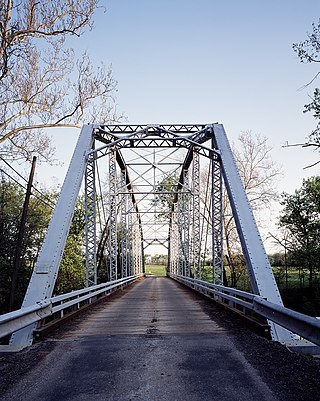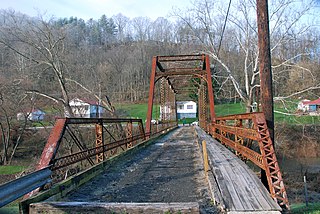
Old Blenheim Bridge was a wooden covered bridge that spanned Schoharie Creek in North Blenheim, New York, United States. With an open span of 210 feet (64 m), it had the second longest span of any surviving single-span covered bridge in the world. The 1862 Bridgeport Covered Bridge in Nevada County, California, currently undergoing repairs due to 1986 flooding is longer overall at 233 feet (71 m) but is argued to have a 208 feet (63 m) clear span. The bridge, opened in 1855, was also one of the oldest of its type in the United States. It was destroyed by flooding resulting from Tropical Storm Irene in 2011. Rebuilding of the bridge commenced in 2017 and was completed in 2018.

Ashokan Bridge is a wooden covered bridge over Esopus Creek on the grounds of the Ashokan Center, in Ulster County. It was built in 1885, and is a single span, gable roofed, covered timber bridge. It measures 72 feet, 6 inches, long and 16 feet, 4 inches, wide. It was originally located at Turnwood and moved to its present location in 1939. It is situated in the Ashokan Center, which was formerly the Ashokan Field Campus of the State University of New York at New Paltz.

The Bullfrog Road Bridge is a historic bridge between Emmitsburg, Frederick County and Taneytown, Carroll County in Maryland. The bridge crosses the Monocacy River on Bullfrog Road between the two counties. This bridge is a rare steel Parker through truss structure and is 183 feet in length and 16 feet-5 inches in width. It was built in 1908, by the York Bridge Company of York, Pennsylvania.

The County Farm Bridge is a historic stone arch bridge in Wilton, New Hampshire. Built in 1885, it carries Old County Farm over Whiting Brook, just south of its northern junction with Burton Highway in a rural section of northwestern Wilton. It is an unusually late and well-preserved example of a 19th-century stone arch bridge, and was listed on the National Register of Historic Places in 1981.

The Carleton Bridge is a historic wooden covered bridge that carries Carlton Road over the South Branch Ashuelot River in East Swanzey, New Hampshire. The bridge was built in 1869, and is the region's only surviving example of a 19th-century Queenspost truss bridge. The bridge was listed on the National Register of Historic Places in 1975.

Bedford Creek Bridge is a historic stone arch bridge located at Hounsfield in Jefferson County, New York. It was constructed in 1825 and spans the Bedford Creek. It is a vernacular, semi-circular stone arch bridge, with a span of 18 feet, 6 inches, and measuring 24 feet long and 21 feet wide.

The ChamberlinMill Covered Bridge, also called Chamberlin Covered Bridge or Whitcomb Covered Bridge, is a historic covered bridge that carries Chamberlain Bridge Road across the South Wheelock Branch of the Passumpsic River in Lyndon, Vermont. Built in 1881, it is one of five similar area bridges. It was listed on the National Register of Historic Places in 1974.
Lalino Stone Arch Bridge is a historic stone arch bridge located near Middleville in Herkimer County, New York. It was constructed in 1870 and spans Perkosky brook a tributary of Maltanner Creek, which empties into West Canada Creek. It is 35 feet long and has a single arch with a span of 23 feet and rise of eight feet, six inches.

AuSable Chasm Bridge is a historic steel arch bridge with concrete and stone faced approach spans that carries US 9 over the Ausable River at AuSable between Clinton and Essex Counties, New York. It was built in 1932–1933. The main span is 222 feet (68 m) in length, with two 52-foot (16 m) foot approach spans, for an overall length with approaches and abutments of 526 feet (160 m). It is approximately 40 feet (12 m) wide, with a span height of 45 feet (14 m) and overall height of 70 feet (21 m).

Notman Bridge is a historic concrete arch bridge over the Ausable River at Keene Valley in Essex County, New York. It was built in 1913 and is an arch bridge faced with stone, 16 feet wide and spanning 62 feet, 6 inches at roughly 14 feet above water level. The bridge is privately owned and access is through the Keene Valley Country Club.
Wilmington Bridge is a historic concrete arch bridge over the Ausable River at Wilmington in Essex County, New York. It was built in 1934 and is an arch bridge faced with stone, 37 feet wide and spanning 160 feet at roughly 24 feet, 8 inches above water level. The bridge is maintained by the New York State Department of Public Works.

Burnsville Bridge is a historic Pratt-Through Truss bridge located at Burnsville, Braxton County, West Virginia. It was built in 1893, by the Variety Iron Works Company or Cleveland, Ohio and crosses the Little Kanawha River. It consists of two Truss spans and one girder span. The three spans are 44 feet, 138 feet, 3 inches, and 23 feet, 9 inches. The structure is supported on two stone piers and a stone abutment.

Duck Run Cable Suspension Bridge, also known as Trubada Swinging Bridge, is a historic cable suspension bridge that spans the Little Kanawha River at Trubada, Gilmer County, West Virginia. The bridge was built in 1922. The bridge is 351 feet, 7 inches, with a main span of 209 feet, 9 inches, and two half spans of 76 feet, 6 inches, and 65 feet, 4 inches. It features four reinforced concrete towers for the two wire rope cables.

The Covered Bridge in Cedarburg, Ozaukee County, Wisconsin, United States, is one of the last remaining covered bridges in that state, which once had about 40 covered bridges. Built in 1876 to cross Cedar Creek, the bridge is 120 feet (37 m) long and is made of pine with oak lattices. It was listed on the National Register of Historic Places in 1973 and is now used only for pedestrian traffic.

Crab Run Lane Truss Bridge is a historic Truss bridge located on State Route 645 in McDowell, Highland County, Virginia. It was built in 1896, by the West Virginia Bridge Works of Wheeling, West Virginia. It is a single-span, four-panel pony truss measuring 39 feet (12 m) long, 12 feet 6 inches (3.81 m) wide, and 5 feet 2 inches (1.57 m) tall. Much of the bridge is constructed of bent and straight steel railroad rails. The bridge was taken out of service for vehicular traffic in 1994; it is now used to carry pedestrian and bicycle traffic.

The Waterloo Covered Bridge carries Newmarket Road over the Warner River near the Waterloo Falls in Warner, New Hampshire. The Town lattice truss bridge was built in 1859–60, replacing an earlier span at the same location, and is one of New Hampshire's few surviving 19th-century covered bridges. The bridge was listed on the National Register of Historic Places in 1976, and included in the Waterloo Historic District in 2003.

The Gilsum Stone Arch Bridge carries Surry Road over the Ashuelot River in Gilsum, New Hampshire. Built in 1862–63, it is one of the highest stone arch bridges in the state. It has a span of 47 feet 8 inches (14.53 m), and an average height over the river of 36 feet 6 inches (11.13 m). The roadway is 43 feet 6 inches (13.26 m) above the riverbed. It stands on the site of four previous bridges, where the river passes through a deep gorge. The previous bridge was also a stone arch bridge, which was built in 1860 and collapsed a few months later. It was designed by William Leonard Kingsbury, a local official; its builders are not known because the town's records were destroyed in a fire. The present bridge's vault is carefully constructed from dry-laid granite voussoirs that were shaped for a very precise fit, with larger stones at the lower ends of the arch, and a smaller ones at the crown. Some of the stones were left with rough surfaces, while others were hammered smooth.

The Gould's Mill Bridge is a historic Baltimore through truss bridge, carrying Paddock Street across the Black River in Springfield, Vermont. The bridge was built by the Boston Bridge Works Company in 1929 after major flooding in 1927, and is one of the state's few examples of a Baltimore truss. It was listed on the National Register of Historic Places in 2006.

Bridge 9 is a historic Parker through truss bridge, carrying Shawville Road across the Missisquoi River in Sheldon, Vermont. Built in 1928 after Vermont's devastating 1927 floods, it is one of the few surviving Parker truss bridges on the Missisquoi. It was listed on the National Register of Historic Places in 2007.

Bridge 12 is a historic Parker through truss bridge, carrying Boston Post Road across the Missisquoi River in Enosburg, Vermont. Built in 1929 in the wake of Vermont's devastating 1927 floods, it is one a shrinking number of surviving truss bridges on the river. It was listed on the National Register of Historic Places in 2007.






















